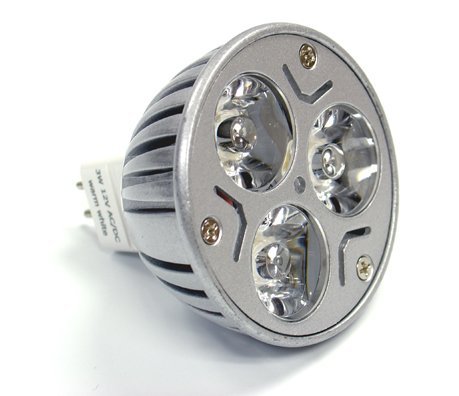We are proud to introduce our all new super bright LED replacement bulb for any standard MR16 application. This bulb works with a 3.7 watt LED to give you 30 degree spot illumination that is comparable to a 20-30 watt incandescent bulb. By replacing your standard incandescent MR16 bulbs with LEDs you will reduce greenhouse gases by consuming less energy. As a result your energy costs will go down significantly as well. This High Power MR16 costs less than .00 per year to operate. (cost to operate taken based on national KWH costs, and an estimated 8 hour per day usage). We offer 1 year product on This Product.
Product Features
- color:white 255lum / warm white:196 lumen
- 90-Percent more efficient than incandescent and halogen
- Long lasting up to 50,000 hours
- Mercury free/environmentally friendly, No UV emissions
- Resists shock and vibration






good enough… could be better. Updated:Choosing a LED is a hard thing (even for a professional landscape light person like myself)Now that the bulbs have come WAY down in price, it makes sense that everyone start considering switching. Less wattage means less money. At an electric cost running around $0.14 per Kilowatt-hours cutting your wattage down can really pay off over time. This LED light bulb gives a nice light with the light spectrum slighting cooler (more white guessing closer to 3150k-3450k) than a standard halogen 35 watt bulb 2800-3050, acceptable. I think ALL the LED manufacturers need to design their LED bulbs so they are slighting shorter than a standard halogen bulb. I find these will not fit in all MR16 enclosed fixtures. For the price, they can not be beat, even just to try one. Time will tell how they hold up. If you are using this on red brick or a white brick/siding home or a white river birch or green shrubs, these are perfect. Anything dark brown you probably will need to try another more warmer (yellow) type of LED.I bought Multiple different LED brand MR16s to try out to find the BEST; I will review each and update each of my ‘reviews’ as I can.FYI:Standard Halogen Bulbs give a 2750k-3050k color. The colorer closer to white/blue would go into the 3550-10000 range. Normal Daylight spectrum is around 5500k-7500k and usually are very hard on the eyes to look at night. If you are lighting things that are white or green. This is a great light.Bulb Lumens or LM are affected by voltage reading at the bulb, if less than 12 volts, dimmer, more than 12 volts brighter, if voltage is not in range of 10.5 and 12 volts, bulb will burn out faster. LED bulbs have wider voltage ranges, and tend not to change brightness in these larger ranges like other halogen bulbs.EG: 10 Watt Halogen=100+/- lumens ; 15 watt gr4=150+/- lumens; 20 Watt g4 Halogen=200+/- lumens; 35 Watt mr16 Halogen=320+/- lumens; 50 Watt MR16 Halogen= 590+ to 1500+ LumensHalogen bulbs last around 1,000 to 5,000 hrs depending on voltages idelaly (10.5-12v)… LED bulbs 20,000 to 50,000 hrs not so much dependant on voltage changes (8-16v).If this review helps, please let me know by commenting or hitting the YES button below.
Perfect Match for the 20W and 35W Landscape Lights they Replaced We had three 35W bulbs and five 20W bulbs for a total of 8 bulbs in our front yard. They were installed by a landscaper, so unsure of brand or reason for varying wattages. These are used in an urban environment for the dual purpose of ornamentally highlighting the home and for adding extra light (security) for passersby on the sidewalk. They aim light up the side of the house, through small bushes and small trees.Because LEDs are new I just ordered one of these 3W LEDs. I was concerned about color of the light, lumens, and width of the beam. I was also concerned about whether or not this MR16 LED would fit into the landscape light fixtures.We were unable to tell the difference between the color, lumens, or beam width between this LED and the pre-existing 20W and 35W bulbs. That raises the question of why we can’t notice a difference between the 20W and 35W bulbs. After consideration, it’s probably the outdoor use and application that makes it difficult to notice. The outdoor lenses are covered in dust and dirt. All of these lights shoot upward toward the house through bushes, trees, or other plants. ‘We would, however, perceive a color change. We tried other LEDs inside the home and note that they have a green color compared to incandescents. In contrast, these 3W MR16’s (warm white version) have a light color indistinguishable from the 20W and 35W halogens the landscaper had installed – presumably from home depot’s lighting aisle.We’ll probably order 7 more of these LED’s, which will take our total wattage from 205W to 24W.The math is pretty interesting on this. Our electric cost is $.11/kwh (from electric bill). These landscape lights probably run about 12hours/day throughout the year (longer in winter, shorter in summer). An online electricity cost calculator says that the current 205Watt MR16 setup costs $98.50 per year. The new 24W LED system will cost $11.50 per year; electric bill savings of $87/year. Amazon is selling these for $12.50, so it’s $100 for eight bulbs.Of course, the number of hours that the old bulbs last is much lower than the expected lifetime of the new LED’s, which would be part of a cost-comparison, but that’s really an open question. In other words, when CFL’s were claiming great efficiencies and extended bulb life, we believed the packages but were disappointed. Some of the CFL’s burned out faster than incandescents because we installed them into places with frequent on/off switching. For that reason, we’ll just wait to see how this LED makes it through the winter.
Successfully replaced my 50 Watt halogen bulbs I used this product to successfully replace my 50 Watt halogen bulbs which are on a low voltage track light with a dimmer. They are not quite as bright as the 50 Watt halogen bulbs but I had those dimmed 30% so for my application it is perfect. As for dimming, the LED is dimmable but isn’t capable of dimming to extremely low light levels like a halogen bulb. The only negative with the new bulbs is that with their riveted exterior makes it somewhat difficult to squeeze them in between the brackets on my track light fixtures.I did some quick math on my application and because I spend 10 cents per kWh and use the bulbs about 4 hours per day, the new bulbs will pay for themselves in 1.8 years with an IRR of 47%. For my 24 bulbs I will spend $300 and save $165 per year. I’ll take that kind of return all day long. This doesn’t even include the fact that LEDs will last significantly longer than halogen bulbs or that they emit less heat (which is a factor as I live in Arizona).
Comments are disabled for this post.